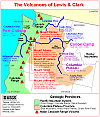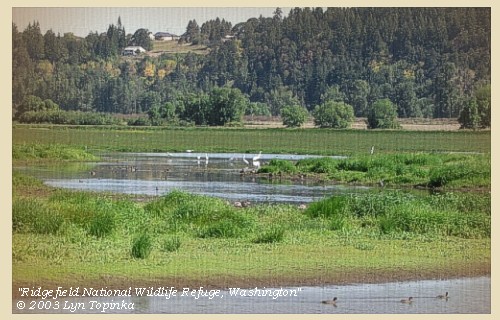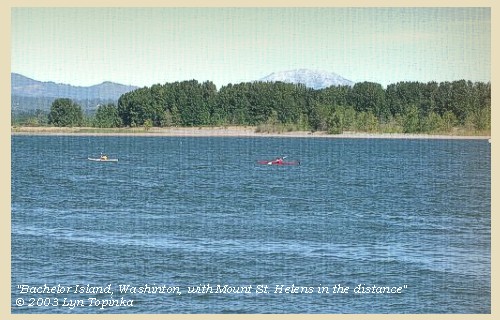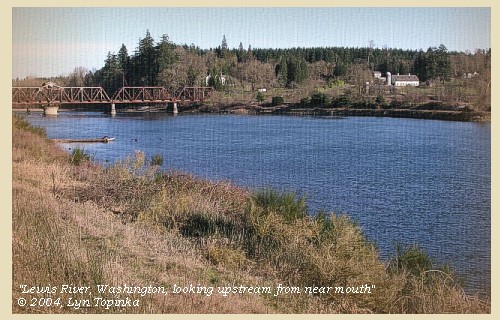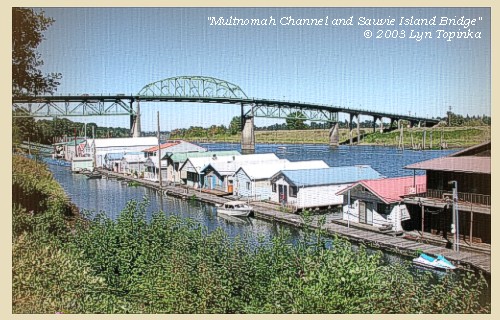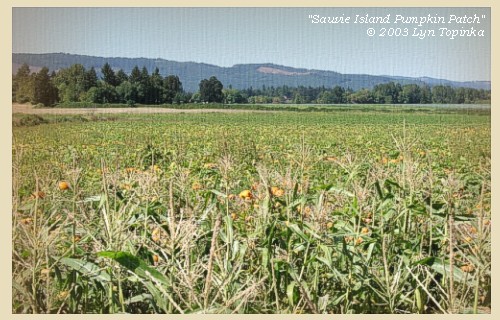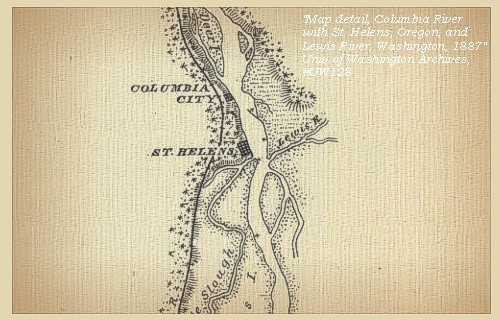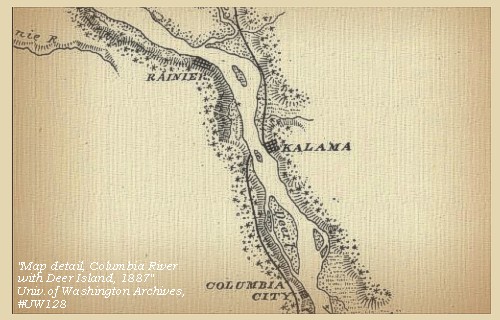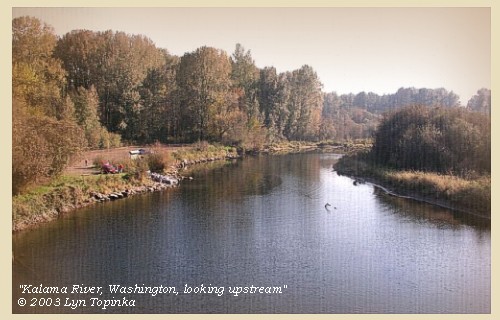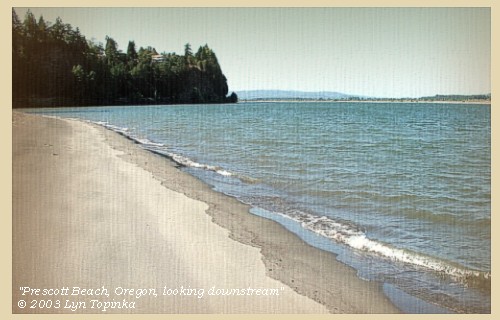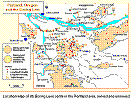The Volcanoes of
Lewis and Clark
Lewis and Clark
|
November 5, 1805 Heading to the Pacific - Ridgefield to Prescott Beach |
|
Home
The Volcanoes of Lewis and Clark Map of the Journey Volcanoes, Basalt Plateaus, Major Rivers, etc. The Volcanoes Mount Adams, Mount Hood, Mount Jefferson, Mount Rainier, and Mount St. Helens CALENDAR of the Journey October 1805 to June 1806 Along the Journey Pacific Northwest Maps - Columbia River, Volcanoes, Flood Basalts, Missoula Floods, Geology, etc. The Corps of Discovery The Journey of Lewis and Clark About the Reference Materials The Journals, Biddle/Allen, DeVoto, Gass, Moulton, Topo Maps, and others USGS Lewis and Clark Links Links to USGS Websites highlighting the Lewis and Clark Journey Resources Publications Referenced and Websites Visited |
PREVIOUS
November 4 Vancouver, Washington, Columbia River Slough to Ridgefield NWR |
November 5
Heading to the Pacific, Ridgefield NWR to Prescott Beach, Oregon Ridgefield NWR, Bachelor Island, Lewis River, Warrior Point, Multnomah Channel, Sauvie Island, St. Helens (Oregon), Mount St. Helens, Mount Adams, and Mount Hood, Martin Bluff, Deer Island, Goble Volcanics, Kalama River, Prescott Beach, Coast Range, Puget Trough and the Willamette Valley, Boring Lava Field |
CONTINUE
November 6 Heading to the Pacific, Prescott Beach to Wallace Island |
|
To the Pacific - November 1805
Heading to the Pacific - Ridgefield to Prescott Beach |
| Lewis and Clark's camp of November 4, 1805, was in today's Ridgefield National Wildlife Refuge. |
| Tuesday, November 5, 1805 |
| Our choice of a camp had been very unfortunate; for on a sand island opposite to us [???] were immense numbers of geese, swan-ducks, and other wild fowl, who, during the whole night, serenaded us with a confusion of noises which completely prevented our sleeping. [Ridgefield National Wildlife Refuge] During the latter part of the night it rained, and we therefore willingly left our encampment at an early hour. |
| "... Rained all the after part of last night, rain continues this morning, I lept but verry little last night for the noise Kept dureing the whole of the night by the Swans, Geese, white & Grey Brant Ducks &c. on a Small Sand Island close under the Lard. Side; they were emensely noumerous, and their noise horid ..." [Clark, November 5, 1805] |
| We passed at three miles a small prairie, where the river is only three quarters of a mile in width. ...... At eight miles we came to the lower point of an island [the island there today is Bachelor Island], separated from the right side by a narrow channel [Bachelor Island Slough], |
| on which, a short distance above the end of the island, is situated a large village ...... the front has fourteen houses, which are ranged for a quarter of a mile along the channel. ...... |
| The Lewis River enters the Columbia River at the downstream end of Bachelor Island. Lewis and Clark missed the mouth of the Lewis River on their journey in 1805, but noted it in the journals on March 29, 1806, on the return. |
| The river here again widens to the space of a mile and a half. As we descended we soon observed, behind a sharp point of rocks [Warrior Point on Sauvie Island], |
|
|
|
Warrior Point:
Both the northern quarter-mile of the tip of Sauvie Island (Warrior Point) and the usually submerged Warrior Rock are composed of the hard black Columbia River basalt that also underlies the city of St. Helens, Oregon. These basalts are part of the series of lava flows that came down the ancestral Columbia River valley 12 million to 14 million years ago. Warrior Rock is a basalt reef that lies beneath the surface of the Columbia River during high water, near the east side of Sauvie Island, three-quarters of a mile south of its northern tip. Warrior Rock takes it name from Warrior Point, the prominent basalt pinnacle that stands 38 feet above sea level near the north end of Sauvie Island. Nathaniel Wyeth of Boston established a temporary fort in 1832 at Warrior Point. -- Allen, 1985, Time Travel in Oregon, and St. Helens Chamber of Commerce Website, 2003 |
| a channel a quarter of a mile wide [Multnomah Channel], |
| which we suppose must be the one taken by the canoes yesterday on leaving Image-canoe island [the upstream end of Sauvie Island, on the 1805 journey down the Columbia, Lewis and Clark did not separate Sauvie Island from Hayden Island.]. |
| A mile below the channel [Multnomah Channel] are some low cliffs of rocks [on the left bank is the location of today's St. Helens, Oregon] |
| near which is a large island on the right side, and two small islands a little further on. Here we met two canoes ascending the river. At this place the shore on the right becomes bold and rocky, [Martin Bluff] and the bank is bordered by a range of high hills covered with a thick growth of pine: |
| on the other side is an extensive low island [Deer Island], separated from the left side by a narrow channel. |
| Here we stopped to dine [Deer Island], and found the island open, with an abundant growth of grass, and a number of ponds well supplied with fowls; and at the lower extremity are the remains of an old village. We procured a swan, several ducks, and a brant, and saw some deer on the island. Besides this island, the lower extremity of which is seventeen miles from the channel just mentioned, we passed two or three smaller ones in the same distance. Here the hills on the right retire from the river, leaving a high plain [location of today's Woodland, Washington, on the flood plains of the Lewis River], between which, on the left bank, a range of high hills running southeast and covered with pine, forms a bold and rocky shore. At the distance of six miles, however, these hills again return and close the river on both sides [near Goble, Oregon and Kalama, Washington]. |
| We proceeded on, and at four miles reached a creek on the right [Kalama River], about twenty yards in width, immediately below which is an old village. |
| Three miles further, and at the distance of thirty-two miles from our camp of last night, we halted under a point of highland, with thick pine trees on the left bank of the river. [Prescott Beach County Park] ...... |
| The river is here deep, and about a mile and a half in width. Here too the ridge of low mountains [The Coast Range] running northwest and southeast, |
|
|
|
Coast Range:
The Coast Ranges, which border the entire west coast of the United States from the Olympic Peninsula south to Mexico, vary greatly in both rock type and climate. Upper Mesozoic and Tertiary sedimentary rocks predominate, although intrusive and metamorphic rocks are also present. Most rocks have been folded, faulted, and in places intensely sheared; many of the Tertiary rocks are poorly consolidated. Topography is mountainous, with steep slopes and intervening flat valleys. Precipitation in the Coast Ranges is seasonal, ranging from very wet in parts of the northern ranges to semiarid in the south, with periodic storms accompanied by intense rainfall. The combination of steep slopes, soft, sheared rocks, and periods of heavy precipitation makes this subdivision, particularly in California, one of the most landslide prone areas of the United States. Tectonic melange, especially that of the Franciscan assemblage, is especially slide prone; landslides on natural slopes are common in all three categories of slide, fall, and flow. Debris flows during rainstorms are a particular hazard in southern California, where much of the area is heavily developed, so that many landslides have been artificially activated. The Coast Ranges are seismically active, and earthquakes have triggered many landslides. -- Radbruch-Hall, et.al., 1982, USGS Professional Paper 1183 |
| cross the river, and form the western boundary of the plain through which we have just passed [The Willamette Valley/Puget Trough]. This great plain or valley begins above the mouth of Quicksand river [Sandy River], and is about sixty miles wide in a straight line, while on the right and left it extends to a great distance: it is a fertile and delightful country, shaded by thick groves of tall timber, watered by small ponds, and running on both sides of the river. The soil is rich, and capable of any species of culture; but in the present condition of the Indians, its chief production is the wappatoo root, which grows spontaneously and exclusively in this region. Sheltered as it is on both sides, the temperature is much milder than that of the surrounding country; for even at this season of the year we observe very little appearance of frost. During its whole extent it is inhabited by numerous tribes of Indians, who either reside in it permanently, or visit its waters in quest of fish and wappatoo roots: we gave it the name of the Columbia valley. |
|
|
|
The Camp - November 5, 1805:
Lewis and Clark's camp of November 5, 1805, was "under a point of high ground, with thick pine trees", near the location of Prescott Beach County Park, Oregon. |
| Home | Previous | Continue |
If you have questions or comments please contact: GS-CVO-WEB@usgs.gov
June/July 2004, Lyn Topinka
The Volcanoes of Lewis and Clark Home Page | CVO Home Page

